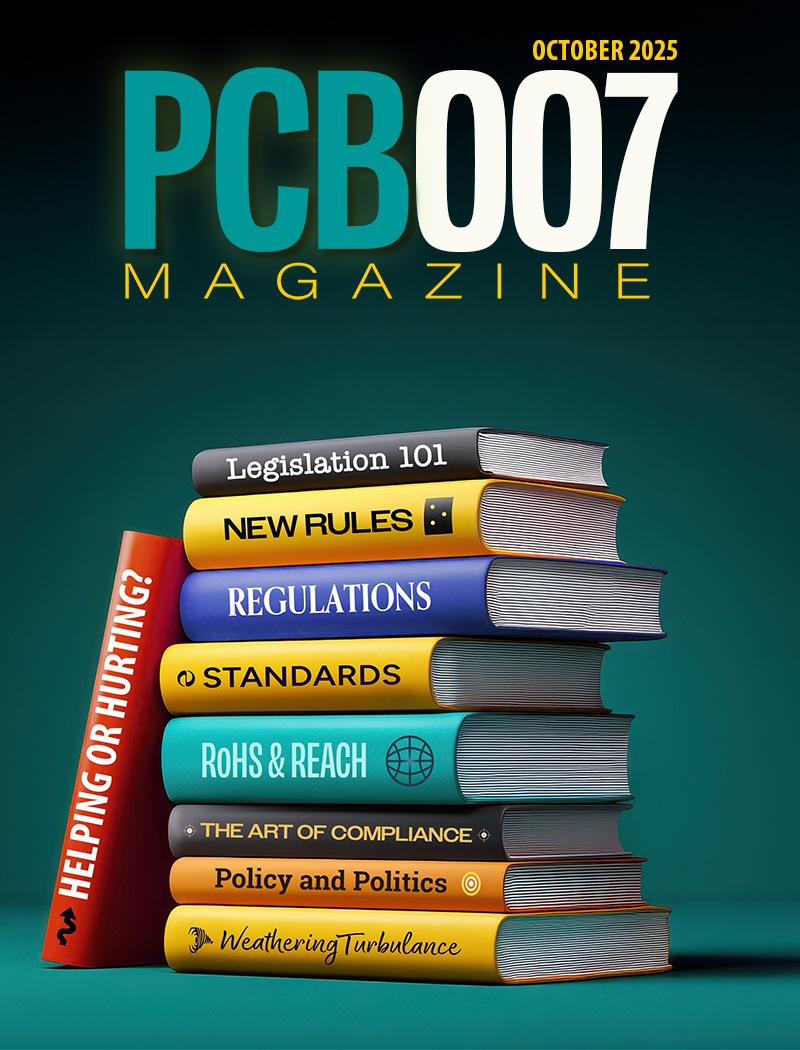-

- News
- Books
Featured Books
- pcb007 Magazine
Latest Issues
Current Issue
The Legislative Outlook: Helping or Hurting?
This month, we examine the rules and laws shaping the current global business landscape and how these factors may open some doors but may also complicate business operations, making profitability more challenging.

Advancing the Advanced Materials Discussion
Moore’s Law is no more, and the advanced material solutions to grapple with this reality are surprising, stunning, and perhaps a bit daunting. Buckle up for a dive into advanced materials and a glimpse into the next chapters of electronics manufacturing.

Inventing the Future With SEL
Two years after launching its state-of-the-art PCB facility, SEL shares lessons in vision, execution, and innovation, plus insights from industry icons and technology leaders shaping the future of PCB fabrication.
- Articles
- Columns
- Links
- Media kit
||| MENU - pcb007 Magazine
Estimated reading time: 3 minutes
Operational Excellence: Sharpening Your Organization’s Competencies
Successful organizations invest in developing their employees into high performers and continuously recruit top talent to join the organization. These actions require effort and commitment from the organization’s leadership, given that employee development and strategic recruitment is a journey of growth and long-term sustainability where a positive return on investment may take years to realize.
The foundation of a successful employee development program is to evaluate and sharpen your employees’ competencies and recruit prospective candidates that possess the desired competencies for which that you are looking. In this column, I will provide an approach on how to develop an employee development program driven by competencies.
How Is Competence Defined?
Competence is constructed from three elements: skill, knowledge, and attribute[1]. A skill is something you do well—your ability to choose and perform the right technique at the right time. It’s usually developed through training and practice. For example, you could become a skilled writer by practicing writing in a particular style, and you can become skilled at being safe in the workplace by practicing techniques during classroom exercises or labs.
Knowledge is information you know—including theories, facts, and procedures—and the ability to apply this information in different situations. For instance, you could have knowledge about different communication styles, or you may know the key steps to plan a program or project and be well-versed in strategies for evaluating success.
An attribute is an inherent characteristic or quality and is often expressed through what you think, do, and feel. For example, you could be known for staying positive and calm in challenging situations. You may also bring a can-do attitude to your work.
Leadership Competencies
It starts at the top. Harvard Business Review did a survey with 195 global leaders who were asked to rate 74 leadership qualities [2], and 10 leadership competencies rose to the top (Table 1). Your organization should prepare an assessment to evaluate your leadership competencies strengths to these top 10 leadership skills and prepare a development plan to strengthen these top competencies as needed within your executive team.
Develop a Framework of Key Competencies for All Employees
Your company culture is defined by core values. The core values will define the DNA of your organization, and employees will demonstrate behaviors that are aligned to those core values. The second component to strengthen your culture is to have a well-defined set of competencies that your organization values in its employees and prospective candidates that will join the company.
Here is an assessment tool based on 38 core competencies defined by Korn Ferry’s research guide and technical manual [3]. These competencies are grouped into factors. The goal is for your executive team to designate a weighted score for each competency. This allows you to provide higher value to a given competency that supports your customers’ values and vision (Table 2).
Once you have built the evaluation tool, you should evaluate each employee to identify areas where improvement is needed. This tool should be a positive and collaborative exercise between a manager and an employee. Employees appreciate seeing the areas where they need to improve on to achieve a high level of consistent performance.
Hire Talent Based on Desired Competencies
Once you have defined a competencies framework and evaluated your workforce, the next step is to recruit and hire new employees by evaluating their competency level to this framework. This allows you to have an objective and quantitative approach to your hiring strategy. Develop an interview worksheet that uses the competencies in the framework. Given the limited time during the interview time that you have with a prospective candidate, I suggest you select a minimum of 10 critical competencies that are most relevant to the position you are hiring for and assess your candidates with those selected competencies.
References
- CGMA, “CGMA Competency Framework: 2019 Update,” 2019.
- S. Giles, “The Most Important Leadership Competencies, According to Leaders Around the World,” Harvard Business Review, March 15, 2016.
- Korn Ferry, “Korn Ferry Leadership Architect: Global Competency Framework—Research Guide and Technical Manual,” 2014–2017.
More Columns from Operational Excellence
Operational Excellence: Strengthen Your Design Transfer Process With Agile NPIOperational Excellence: Redefine Recruiting to Attract and Hire the Right Talent
Operational Excellence: Process Effectiveness Qualification
Operational Excellence: Working Remotely–Redesign Your Information Systems
Operational Excellence: Hiring and Retaining Top Employees
Operational Excellence: Update Your Business Contingency Plan
Operational Excellence: The Gemba Transformation of Manufacturing With AI
Operational Excellence: Hiring and Retaining Top Employees


